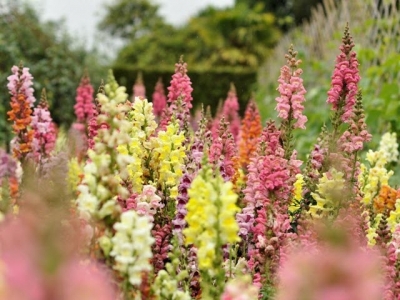Growing Snapdragons Flowers: A How To Guide

Snapdragons get their name from the shape of the flowers, which children love to squeeze to make the “dragon” open and close its mouth. These colorful annuals come in just about every shade and combination of pink, red, and yellow you can imagine. The mainstay of old-fashioned flower gardens, they play just as important a role in today’s modern gardens.
Planting and Care for Snapdragons
Snapdragons are easy to grown. You will have success if you grown them in well-drained garden soil. In most locations snapdragons need full sun, but because they stop flowering when it gets too hot, they prefer partial shade in hot, sunny climates.
Snapdragons are not heavy feeders, so if you add compost to the soil that might be all the food they need to grow strong and bloom profusely.
You can either sow snapdragon seeds indoors ten weeks before the last frost date or buy transplants. (In Southern California and similarly hot places gardeners sow their snapdragon seeds in fall or winter for spring blooming.) Plant seedlings of small varieties six to eight inches apart; taller types need twelve inches between plants.
Spacing depends on the ultimate size of your snapdragons, which can be anywhere from eight inches to four feet tall.
Water regularly if there’s not enough rain, and remove any weeds. Mulching will help conserve water and keep the weeds down. If you remove spent flowers your plants will keep blooming until the weather gets too hot. When the plants stop producing flowers cut the stems down to about five inches from the ground. Water well, and you are likely to get another flush of flowers before frost kills the plants.
Snapdragon Pests and Diseases
Snapdragons are vulnerable to a number of fungal diseases. Good air circulation in the garden, avoiding overhead watering, and keeping the garden area clean will help avoid these problems.
Landscape Uses and Snapdragons
Small snapdragons are delightful bedding plants, mixing well with other annuals in the flower garden. Tall varieties are excellent in flower arrangements, along a fence, and planted in the back of a border. You may need to stake the tall, old-fashioned varieties.
Snapdragon Propagation
Some gardeners let their snapdragons go to seed and collect the seeds. The best way to ensure you get the snaps you want, however, is to buy transplants or seeds from a reputable source.
Related news
 Planting tomatoes brings hope to orphans
Planting tomatoes brings hope to orphans Investing R1,5 million in a technologically advanced greenhouse has increased tomato yields and profit at Valley Fresh, a social profit enterprise supporting
 Herbs – a beginner’s success story
Herbs – a beginner’s success story While many emerging farmers usually battle to survive, being thrown in the deep end helped organic farmer Jimmy Ka-Botha to succeed. Today he supplies Woolworth
